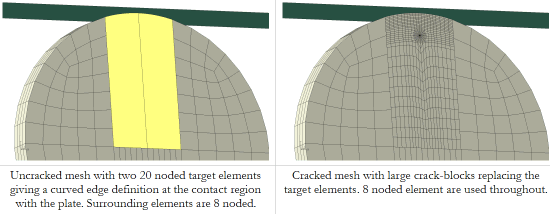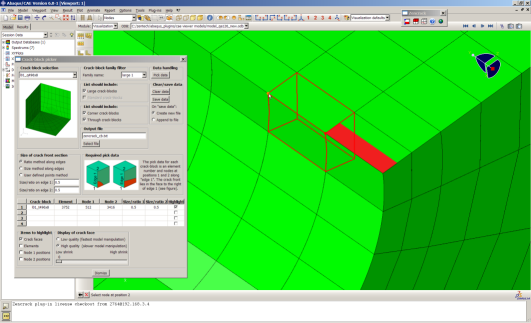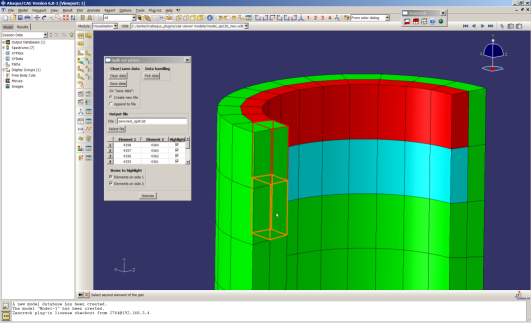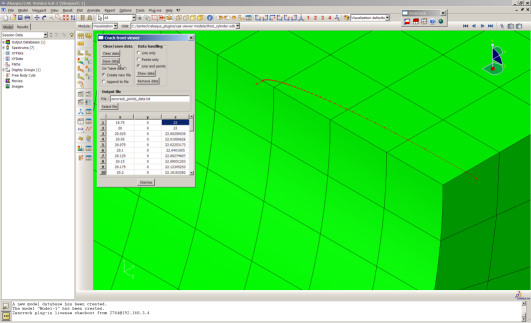- Software
- Zencrack
- What’s New in Zencrack?
Zencrack 7.6
What's New in Zencrack?
Zencrack 7.6
Zencrack version 7.6 was finalised on 19 February 2009
General
- The documentation has been split into a number of separate manuals to make it easier for the user, in particular the new user, to locate information. In addition, there has been a significant amount of re-writing and re-ordering of sections in the main user manual to make the Zencrack analysis process simpler to understand.
- A new keyword, *ELEMENT, is introduced to allow a 20 noded target element to be replaced by 8 noded elements in the crack-blocks of the cracked mesh. This can be useful in cases where 8 noded elements are required for analysis reasons (e.g. contact) but the crack-block is required to have curved edges. An example of such a situation is shown here. This option operates only on large crack-blocks and their transition elements and is implemented for the Abaqus and Ansys interfaces only.

Example of *ELEMENT keyword
- The restriction that the uncracked mesh cannot contain a mixture of 8 and 20 noded brick elements is removed. The only condition that remains is that all target elements on a crack front must be of the same type. In the case of standard crack-blocks the elements surrounding the crack-blocks should also be of the same type. But 8 and 20 noded crack fronts can exist at different locations within the same model if required.
- A number of changes have been made to improve the use of the bk1 and bk2 files for detailed processing of output from spectrum load histories:
- the data available in the bk1 and bk2 file is increased:
- the bk1 file is made a csv file for direct import into Excel.
- an option is added to *OUTPUT to control which integration pass is written to the bk1 and bk2 files with only pass 2 being written by default.
- A number of improvements have been made in the options available for defining minimum and maximum load systems:
- The existing *LOAD SYSTEM, ENERGY=SEARCH option has been extended to allow definition of the start and end result set numbers that should be used for the search. These positions are defined using new parameters START SEARCH and END SEARCH.
- For the Abaqus interface options are added to allow the start and end of the search to be defined in terms of cross reference to Abaqus step and increment numbers. The new parameters START STEP, START INC, END STEP and END INC can be used for this method of search definition.
- A combination option is added to allow a minimum or maximum load system to be defined by linear combination of one or two previously defined minimum or maximum conditions. To use this method the ENERGY=COMBINATION option is used with the new parameters SYSTEM 1, SYSTEM 2, FACTOR 1 and FACTOR 2.
- The spline fixup option on the CRACK FRONT keyword has been improved for cases where the crack front is not normal to the free surface. In addition the distribution of crack-blocks along the crack front no longer has to be uniform when the spline fixup is used - the initial spacing of the crack-blocks can be used instead. This is controlled with the new parameter DISTRIBUTION.
- A number of improvements have been made in the surround fix option on the BOUNDARY SHIFT keyword including catering for cases where the surrounding mesh is not a rectangular grid of elements.
- The calculation of displacement-based Ks can now be turned off (and is also turned off if the Ct-integral is requested rather than the J-integral).
- In the error control scheme for defining the allowable step sizes between successive finite element analyses a reduced step size is used in the initial steps. A cut-back in step size based on a cube power over the first ten analysis steps was used by default in version 7.5. This has been changed to a square power in version 7.6. In general this provides a faster start-up to the analysis with a reduction in the overall number of finite element analyses. For cases with a superposition load system the original cubic power is retained as the default.
- The remote finite element execution facility for Windows
installations that have the finite element code on a Linux or Unix
machine has been improved:
- Ansys solid model analyses can now be run using the remote f.e. capability.
- a more secure protocol (ssh) is available for executing commands on the remote machine.
- a new string, LOGINEXTRA, allows extra options to be defined for the remote access.
- if LOGINEXTRA begins with "fullcommandline" then the rest of the string is assumed to contain the full command line for the t4erexec or t4essh utilities
- A "license roaming" capability is available with network licensing. The capability allows the user to request that license tokens be taken from the main license pool and tied to a particular machine for up to 9 days. The machine can then be disconnected from the network and Zencrack executed on it for the period that the tokens have been acquired. Tokens can be manually returned to the main license pool at any time. If they are not returned they automatically cease to work at the end of the specified period and become available again from the main license pool.
- Eight new user subroutines are included in this release. In addition a number of "utility functions" are included. These can be called from within user subroutines to access certain model data e.g. current coordinates of a node in the model etc.
Abaqus interface
- Three plug-ins are provided in this release for use with Abaqus/CAE and /Viewer. These plug-ins allow extraction of data from a model ready for use in the Zencrack input file and/or provide a visual confirmation that input data is correct.



Ansys interface
- The type of the Ansys uncracked mesh, either "normal" or "solid model", is now determined automatically. There is no longer a requirement to use the "-a solidmodel" command line option for solid model uncracked meshes.
- A considerable amount of change has been made to improve the handling of contact surfaces defined using ESURF.
- The handling of TSHAP options has been improved. Any TSHAP option should now be handled in a meaningful way. Previously TSHAP could not be processed in a solid model file but this is now possible.
- Improvements have been made to cases where the required options, e.g. /PREP7, /SOLU and SOLVE are missing from the uncracked mesh file. The processing of cases where /EXIT is missing is also improved.
- The .001 file that Zencrack uses to extract results from the Ansys analysis is added to the list of files that can be saved and renumbered on the *SAVE keyword.
- The *RESTART, TYPE=FE FILES option is enabled for "normal" Ansys analyses to allow a restart of an analysis without repeating the Ansys runs.
- Ansys solid model analyses can now be run using the remote f.e. capability.
- A new variable OPTIONS_ANSYS is added to the runzcr script to specify Ansys command line options that should be used when Zencrack executes an Ansys job, e.g. a specific Ansys product or number of processors for Ansys execution.
Marc interface
- Support is added for the Marc wide data format defined by the EXTENDED parameter in the uncracked mesh. The cracked mesh will always use the data format (normal or extended) of the uncracked mesh.